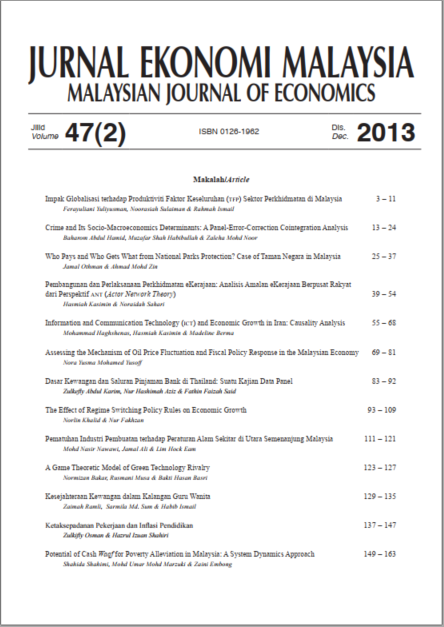Jurnal Ekonomi Malaysia
47 (2) 2013 25 – 37
School of Economics
Faculty of Economics and Management
Universiti Kebangsaan Malaysia
Abstract
The Malaysian National Park or Taman Negara (TN) is a totally protected forest which covers an area over 4,000 square kilometres, straddling across three relatively less developed north-eastern states of Pahang, Terengganu and Kelantan in Peninsular Malaysia. Forest conservation inevitably entails equity-efficiency tradeoffs. The local communities may lose all or most of the direct benefits provided by the resource, including foregone benefits such as agricultural development and other alternative uses. While all the other indirect and non-use values may accrue to both local and external communities, foregone benefits may pose a serious policy issue should the affected communities be relatively poorer or have less access to alternative sources of economic growth and development. This study conducts an economic valuation of the benefits and costs of Taman Negara’s conservation and its resulting equity impacts to the various stakeholders – global community, Malaysian federal and state governments, and the local community. The study specifically compares the benefits from TN conservation against alternative land uses, namely sustainable logging, and sustainable logging and oil palm development. Based on a social discount rate of 2 percent and lower bound price estimates of carbon and marketed goods prices, the study shows that existing conservation policies provide higher economic benefits compared to other land use options. However, at higher discount rates of 5 and 8 percent, the benefits from the conservation management option against alternative uses may turn negative. Overall results demonstrate a clear equity issue between those who benefited from forest conservation and especially the three relatively less developed states which incurred substantial benefits foregone. To address this issue at the national level, it is recommended that national conservation policies consider the establishment of a National Forest Conservation Fund for compensation of environmental services provided by protected forests, similar to the Payment for Environmental Services scheme. Some portion of the revenue from marketed goods provided by the park particularly recreational services may also be allocated to the state governments. At the international level, the ongoing REDD Plus programmes need to take into account cross country equity issue, particularly countries that have long been involved in pre-existing conservation programme such as the Malaysian Taman Negara.
Keywords
Bibliography
@article{othman2013who,
title={Who Pays and Who Gets What from National Parks Protection? Case of Taman Negara in Malaysia},
author={Othman, Jamal and Zin, Ahmad},
journal={Jurnal Ekonomi Malaysia},
volume={47},
number={2},
pages={25—37},
}
Receive updates when new articles are published.


